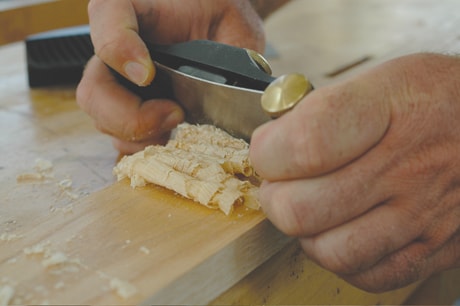If you’re stripping wood finishes, repairing antiques, building new furniture or smoothening any kind of wood surface, there’s an ancient alternative to sandpaper that’s faster, less messy and healthier for you.
This alternative is also quieter than any power sander, though there’s a catch.
You need the skills to sharpen and use this tool correctly, and that’s what I want to introduce you to here.
Cabinet scrapers are very simple hand tools that have been around for centuries.
Push the edge of a scraper across wood at an angle and it removes curly shavings by slicing them off the surface.
Smoothening or stripping of wood with a scraper is faster than a sander and it doesn’t put any dust into the air, either.
That said, this pleasant outcome only happens if the scraper’s edge is sharp.
That’s the key.
During the last 10 years, factory sharpened scrapers have hit the market, and that’s a good thing.
These tools work fairly well for a while without maintenance, and though they’re not quite as effective as shop-sharpened scrapers, they do offer a good introduction to this under-appreciated tool.
The best cabinet scrapers have edges that are more than just crisp, 90-degree corners. If you could see the cutting edge under a microscope, you’d find that it’s actually shaped like a very tiny hook.
This is the thing that slices off curls of wood that scrapers are famous for.
Scrapers made with thicker metal form a larger, more aggressive hook that works best for coarse applications like stripping a floor. Thin scrapers remove less wood, but they do it more finely. Use these for removing paint and old varnish from furniture.
Sharpening your own scrapers takes practice. The process involves making the edge flat and straight with a file and sharpening stone, then burnishing this edge with a hardened steel tool that creates the all-important, microscopically hooked cutting edge.
The biggest breakthrough in developing my own scraper-sharpening success happened when I bought an adjustable burnishing tool. Instead of relying exclusively on hand eye coordination to turn the all-important hook, a burnishing tool regulates this process, making it easy to succeed almost right away.
Once you’ve prepared an effective hook on your scraper (or bought a factory-sharpened model that’s ready to use), the tool needs to be wielded correctly as it’s pushed across wood with your hands. Angling the burnisher accurately and consistently in relation to the wood surface is key to producing proper curls.
Tip the tool about 15 degrees from perpendicular to the wood surface, then push it away from you with moderate pressure while bending the scraper.
Back and forth like this does the trick. Once you get the hang of using the tool, you’ll find that a sharp scraper produces more than just smooth surfaces. It also generates enough heat and pressure to make your thumbs pretty sore after more than a few minutes of use. Solving this problem is where a scraper holder comes in.
This accessory eliminates the problem of heat while introducing a bend in the scraper itself that boosts the aggressiveness of its cut. The scraper fits into the holder, gripped along the edges, and bent with a brass adjustment bolt. The more you turn the bolt, the greater the bend imparted to the scraper, the more aggressively it slices.
Cabinet scrapers are fine woodworking tools that offer value way beyond just making tables and cabinets and shelves. Although you won’t find scrapers and related goodies at regular hardware outlets, they’re stocked by woodworking specialty suppliers everywhere.
Invest time and effort developing your scraper skills and your home improvement projects will get better while your workspace becomes a little quieter and cleaner, too. Sometimes the old ways really are worth remembering.
Steve Maxwell is Canada’s award-winning home improvement expert, and technical editor of Canadian Home Workshop magazine. Sign up for his free homeowner newsletter at www.stevemaxwell.ca
